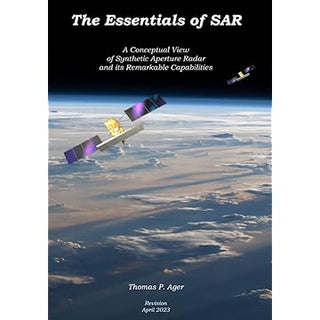The Essentials of SAR : A Conceptual View of Synthetic Aperture Radar and Its Remarkable Capabilities
- Unit price
- / per
-
Author:AGER Thomas
-
ISBN:9798512864487
-
Publication Date:January 2021
-
Edition:1
-
Pages:309
-
Binding:Paperback
-
Publisher:Independently Published
-
Country of Publication:USA


A Back Order button means that we don’t have the book in stock at our store. It may already be on order – or we can order it for you from a publisher or distributor at no additional cost.
As we source items from around the globe, a back-order can take anywhere from 5 days to several weeks to arrive, depending on the title.
To check how long this might take, you’re welcome to contact us and we can provide an ETA or any other information you need. We recommend checking the timeframe before committing to an online order.
The Essentials of SAR : A Conceptual View of Synthetic Aperture Radar and Its Remarkable Capabilities
- Unit price
- / per
-
Author:AGER Thomas
-
ISBN:9798512864487
-
Publication Date:January 2021
-
Edition:1
-
Pages:309
-
Binding:Paperback
-
Publisher:Independently Published
-
Country of Publication:USA
Description
Synthetic Aperture Radar is well known as the imaging technique that can see through clouds and darkness, but SAR remains a confusing and enigmatic sensor. Its images are naturally different from the optical views wired into the human visual system, and SAR has an electrical engineering heritage that is incomprehensible to most people.
This book makes SAR clear and appealing to remote sensing students and professionals who do not have advanced degrees in electrical engineering. It uses expansive explanations, nearly three hundred illustrations and images, a few simple equations, and even a bit of prose and music to describe how SAR works. It seeks to replace the confusion and intimidation of SAR with clarity and comfort.
Adding product to your cart
You may also like
A Back Order button means that we don’t have the book in stock at our store. It may already be on order – or we can order it for you from a publisher or distributor at no additional cost.
As we source items from around the globe, a back-order can take anywhere from 5 days to several weeks to arrive, depending on the title.
To check how long this might take, you’re welcome to contact us and we can provide an ETA or any other information you need. We recommend checking the timeframe before committing to an online order.
You may also like
You may also like
-
Synthetic Aperture Radar is well known as the imaging technique that can see through clouds and darkness, but SAR remains a confusing and enigmatic sensor. Its images are naturally different from the optical views wired into the human visual system, and SAR has an electrical engineering heritage that is incomprehensible to most people.
This book makes SAR clear and appealing to remote sensing students and professionals who do not have advanced degrees in electrical engineering. It uses expansive explanations, nearly three hundred illustrations and images, a few simple equations, and even a bit of prose and music to describe how SAR works. It seeks to replace the confusion and intimidation of SAR with clarity and comfort.
-
-
Author: AGER ThomasISBN: 9798512864487Publication Date: January 2021Edition: 1Pages: 309Binding: PaperbackPublisher: Independently PublishedCountry of Publication: USA
Synthetic Aperture Radar is well known as the imaging technique that can see through clouds and darkness, but SAR remains a confusing and enigmatic sensor. Its images are naturally different from the optical views wired into the human visual system, and SAR has an electrical engineering heritage that is incomprehensible to most people.
This book makes SAR clear and appealing to remote sensing students and professionals who do not have advanced degrees in electrical engineering. It uses expansive explanations, nearly three hundred illustrations and images, a few simple equations, and even a bit of prose and music to describe how SAR works. It seeks to replace the confusion and intimidation of SAR with clarity and comfort.
-
Author: AGER ThomasISBN: 9798512864487Publication Date: January 2021Edition: 1Pages: 309Binding: PaperbackPublisher: Independently PublishedCountry of Publication: USA
-



